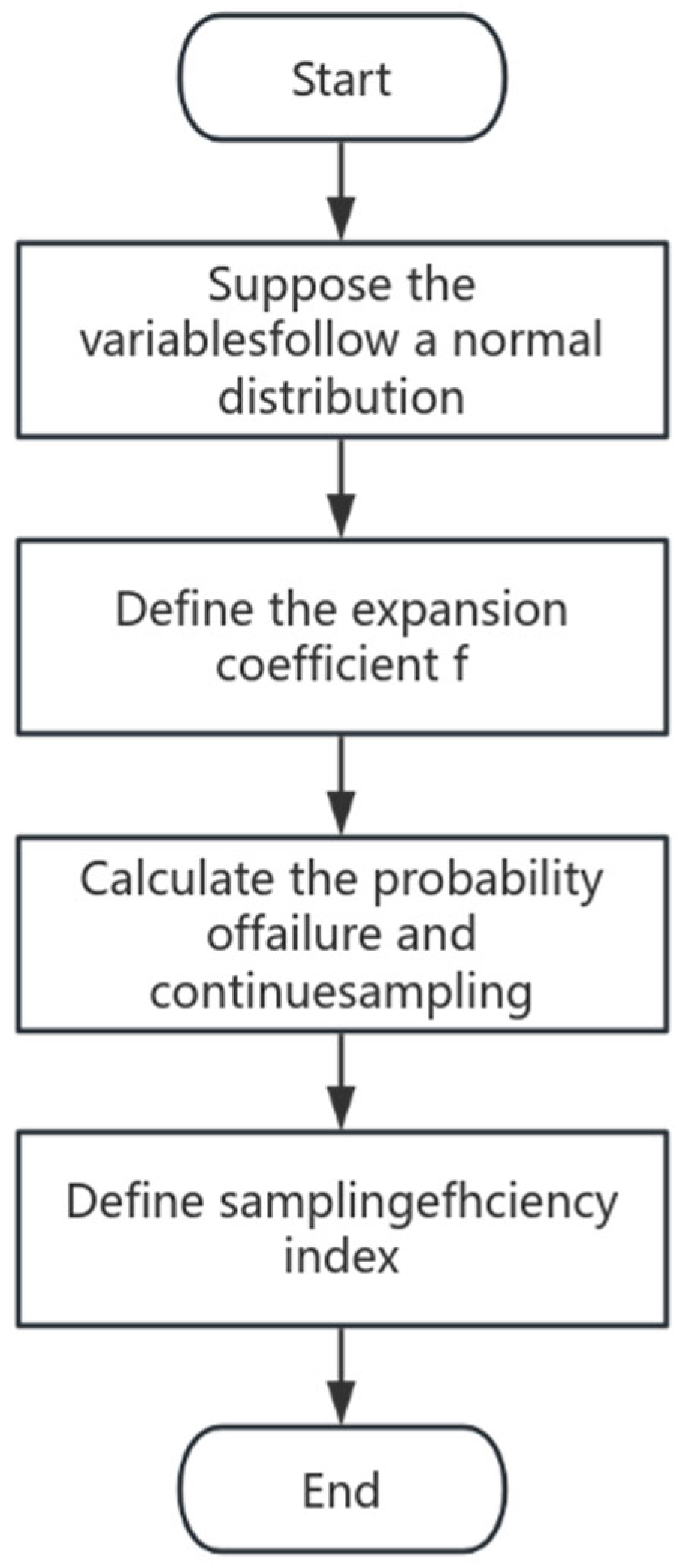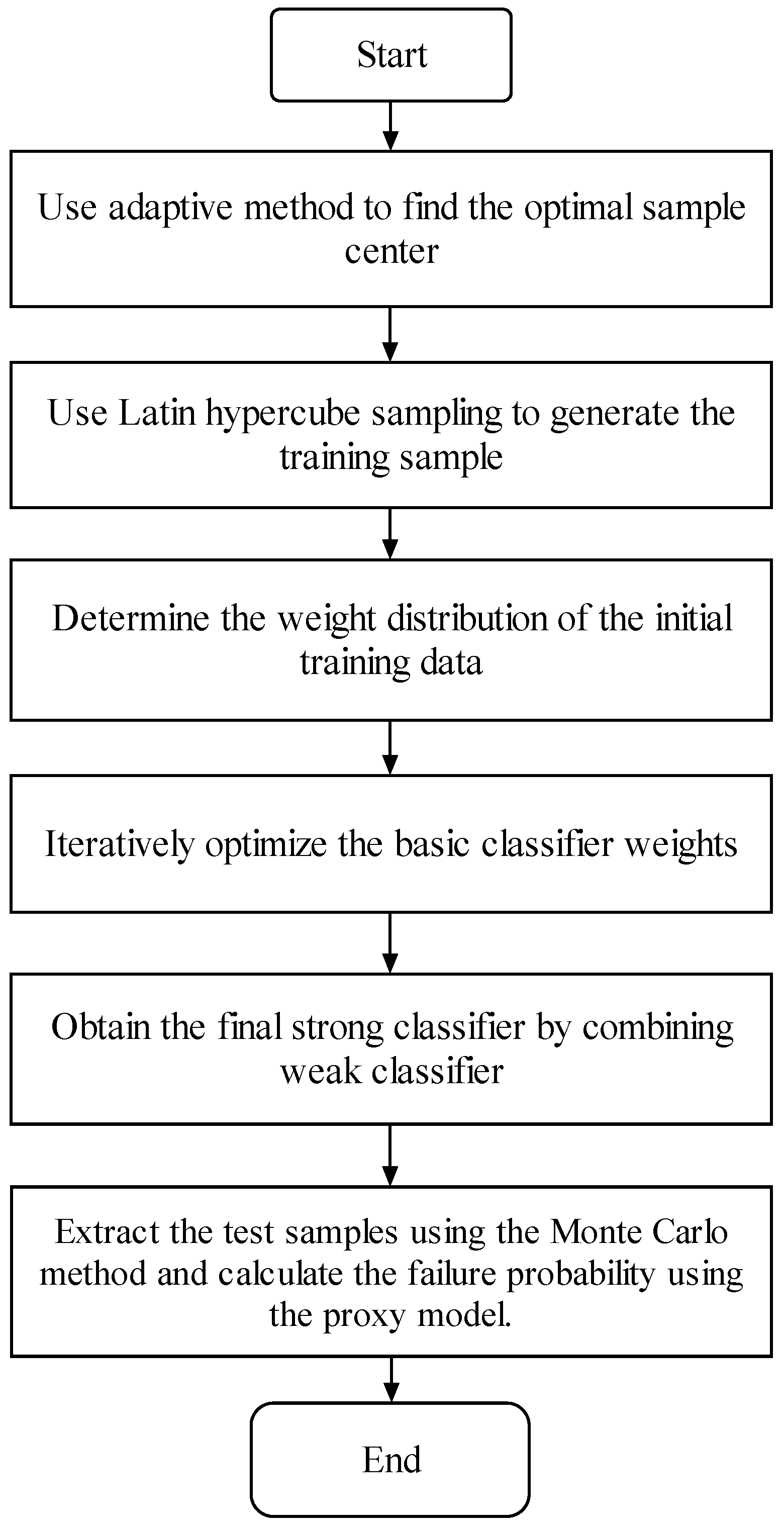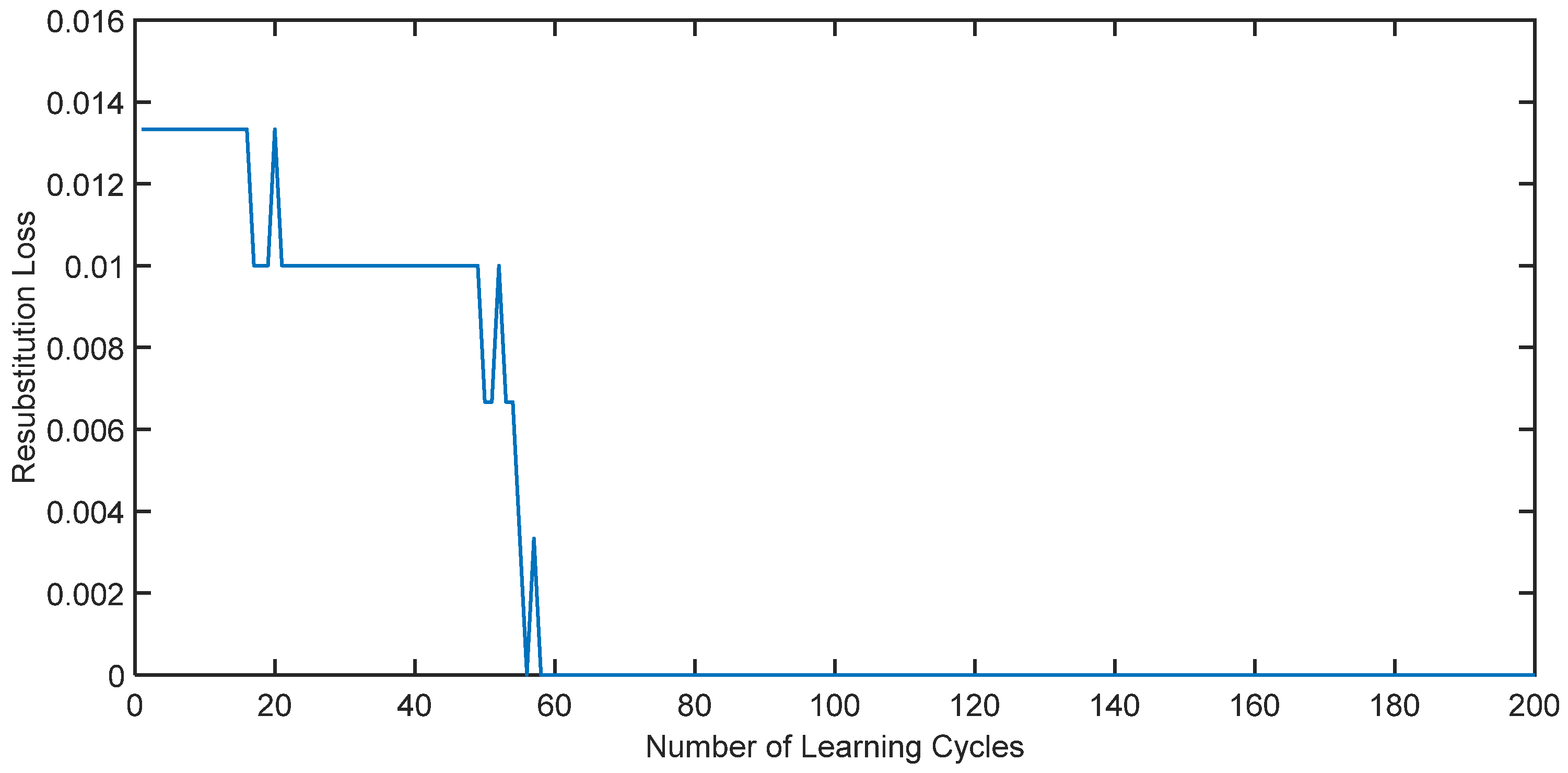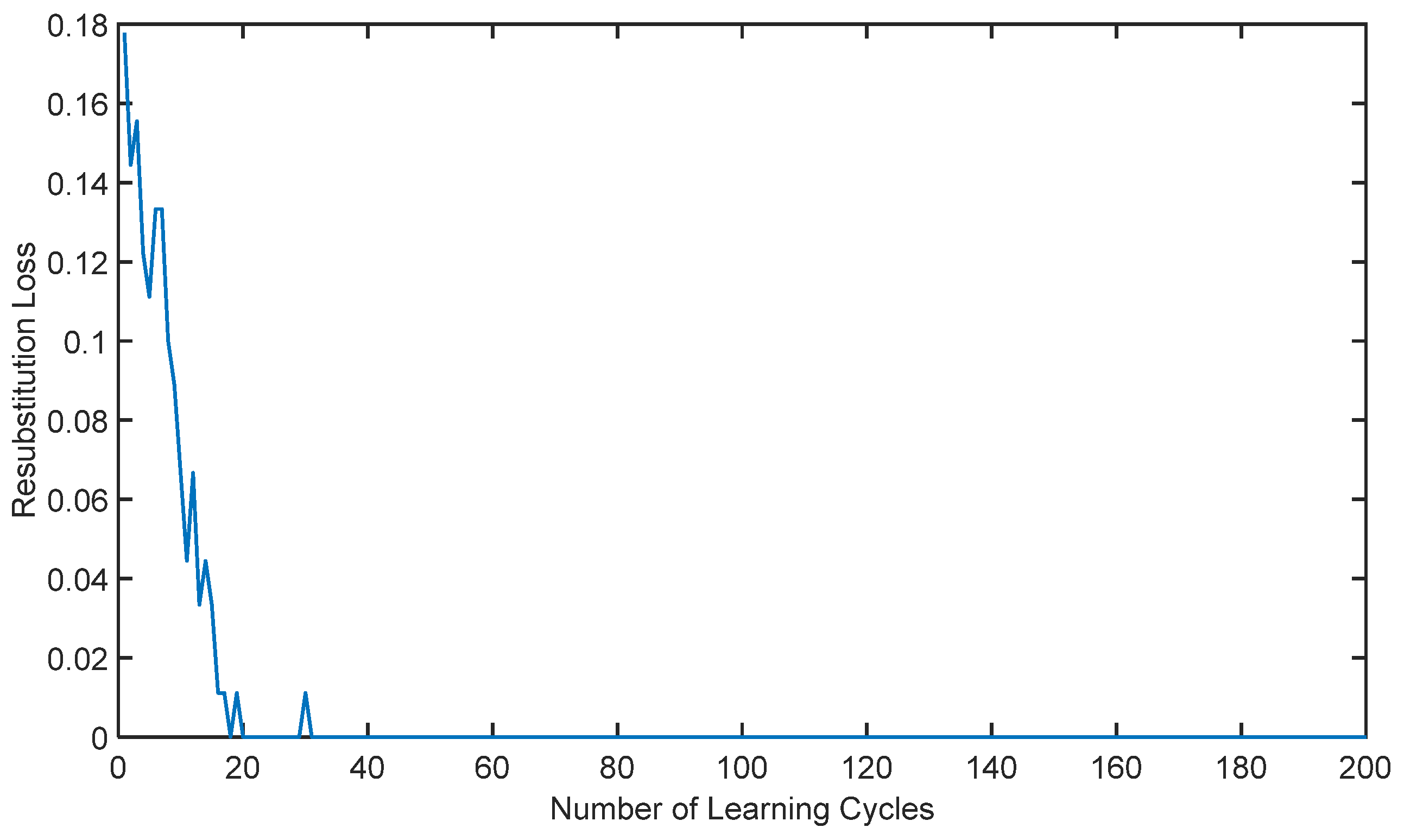Reliability Analysis of Complex Structures Under Multi-Failure Mode Utilizing an Adaptive AdaBoost Algorithm
Abstract
1. Introduction
2. Reliability Analysis Based on the AdaBoost Surrogate Model
2.1. Reliability Modeling of Complex Structures under Multi-Failure Mode
2.2. Adaptive AdaBoost Algorithm
2.2.1. Adaptive Sampling
- (1)
- It is presumed that the variables are mutually independent and follow a normal distribution, .
- (2)
- Define the expanded coefficient, f, and let .
- (3)
- Employ Latin hypercube sampling to derive 200 sample points, and then bring them into the system model for discrimination and calculate failure probability . Select the point with the largest joint probability density from among the failure points; this point is taken as the sampling center for subsequent sampling.
- (4)
- Define a sampling efficiency index, . The smaller the value of , the closer the sampling center is to the optimal design point, and the failure probability approaches 50%.
- (5)
- When , the loop comes to an end. The sampling center at this time is take as the new sampling center, and resampling is conducted using .
2.2.2. AdaBoost Algorithm
2.3. Reliability Analysis Model Based on the Adaptive AdaBoost Algorithm
- (1)
- Use the adaptive method to find the optimal sample center.
- (2)
- According to the sample center, use Latin hypercube sampling to generate training samples.
- (3)
- Initialize the weight distribution of the training data. Assign the same weight to each training sample as follows: .
- (4)
- In the m-th iterations, obtain , which represents the current m-round iterative classifier; obtain , denoting the present classification error; and obtain , which signifies the cumulative coefficient as elaborated below:
- ①
- Obtain the basic classifier by learning the training dataset with a weight distribution of .
- ②
- Calculate the classification error rate of for the training dataset:
- ③
- Calculate the coefficient for , where represents the importance of in the final classifier:It is evident from the preceding equation that and , and that increases as decreases, thereby indicating that basic classifiers with lower classification error rates have a greater impact on the final strong classifier.
- ④
- Update the weight distribution of the training dataset to obtain a new weight distribution for the subsequent interaction:where .As a result, the weights of samples misclassified by the fundamental classifier, , are augmented, whereas the weights of accurately classified samples are diminished. In this manner, the AdaBoost algorithm can concentrate on samples that are more challenging to differentiate.
- (5)
- Integrate the weak classifiers:The ultimate strong classifier is denoted by
- (6)
- Use the Monte Carlo method to calculate the failure probability based on the final strong classifier.
3. Examples
3.1. Parallel System
3.2. Series System
3.3. Engineering Example
3.4. Analysis and Discussion
4. Conclusions
- (1)
- Compared with the traditional Monte Carlo method, this model significantly improves the computational efficiency and can accurately calculate the failure probability in a shorter time.
- (2)
- The method has good universality. Compared with the general alternative model, the adaptive AdaBoost algorithm proposed in this paper has the advantages of strong applicability, low dependence on the operator’s engineering experience, and high precision.
- (3)
- However, we must be aware that the studies conducted to date have some limitations. The adaptive AdaBoost algorithm proposed by us has not been applied to a multi-failure mode reliability analysis of more complex structures. More and more complex research scenarios put forward higher requirements and challenges for our proposed algorithms.
Author Contributions
Funding
Institutional Review Board Statement
Informed Consent Statement
Data Availability Statement
Conflicts of Interest
References
- Yazdi, M.; Golilarz, N.A.; Nedjati, A.; Adesina, K.A. An improved lasso regression model for evaluating the efficiency of intervention actions in a system reliability analysis. Neural Comput. Appl. 2021, 33, 7913–7928. [Google Scholar] [CrossRef]
- Yan, W.; Deng, L.; Zhang, F.; Li, T.; Li, S. Probabilistic machine learning approach to bridge fatigue failure analysis due to vehicular overloading. Eng. Struct. 2019, 193, 91–99. [Google Scholar] [CrossRef]
- Yang, J.; Chen, C.; Ma, A. A Fast Product of Conditional Reduction Method for System Failure Probability Sensitivity Evaluation. CMES-Comput. Model. Eng. Sci. 2020, 125, 1159–1171. [Google Scholar] [CrossRef]
- Zhu, S.-P.; Keshtegar, B.; Trung, N.-T.; Yaseen, Z.M.; Bui, D.T. Reliability-based structural design optimization: Hybridized conjugate mean value approach. Eng. Comput. 2021, 37, 381–394. [Google Scholar] [CrossRef]
- Xu, J.-G.; Cai, Z.-K.; Feng, D.-C. Life-cycle seismic performance assessment of aging RC bridges considering multi-failure modes of bridge columns. Eng. Struct. 2021, 244, 112818. [Google Scholar] [CrossRef]
- Zhang, F.; Xu, X.; Cheng, L.; Tan, S.; Wang, W.; Wu, M. Mechanism reliability and sensitivity analysis method using truncated and correlated normal variables. Saf. Sci. 2020, 125, 104615. [Google Scholar] [CrossRef]
- Marozaua, I.; Auchlina, M.; Pejchal, V.; Souchon, F.; Vogel, D.; Lahti, M.; Saillen, N.; Sereda, O. Reliability assessment and failure mode analysis of MEMS accelerometers for space applications. Microelectron. Reliab. 2018, 88–90, 846–854. [Google Scholar] [CrossRef]
- Wang, R.; Liu, X.; Hu, D.; Mao, J. Reliability assessment for system-level turbine disc structure using LRPIM-based surrogate model considering multi-failure modes correlation. Aerosp. Sci. Technol. 2019, 95, 105422. [Google Scholar] [CrossRef]
- Meng, Z.; Pang, Y.; Pu, Y.; Wang, X. New hybrid reliability-based topology optimization method combining fuzzy and probabilistic models for handling epistemic and aleatory uncertainties. Comput. Methods Appl. Mech. Eng. 2020, 363, 112886. [Google Scholar] [CrossRef]
- Yang, F.; Ren, J. Reliability Analysis Based on Optimization Random Forest Model and MCMC. CMES-Comput. Model. Eng. Sci. 2020, 125, 801–814. [Google Scholar] [CrossRef]
- Monjardin-Quevedo, J.G.; Reyes-Salazar, A.; Tolentino, D.; Gaxiola-Camacho, O.D.; Vazquez-Becerra, G.E.; Gaxiola-Camacho, J.R. Seismic reliability of steel SMFs with deep columns based on PBSD philosophy. Structures 2022, 42, 1–15. [Google Scholar] [CrossRef]
- Guzman-Acevedo, G.M.; Quintana-Rodriguez, J.A.; Gaxiola-Camacho, J.R.; Vazquez-Becerra, G.E.; Torres-Moreno, V.; Monjardin-Quevedo, J.G. The Structural Reliability of the Usumacinta Bridge Using InSAR Time Series of Semi-Static Displacements. Infrastructures 2023, 8, 173. [Google Scholar] [CrossRef]
- Wang, Z. Markov chain Monte Carlo sampling using are servoirmethod. Comput. Stat. Data Anal. 2019, 139, 64–74. [Google Scholar] [CrossRef]
- Liu, X.-X.; Elishakoff, I. A combined Importance Sampling and active learning Kriging reliability method for small failure probability with random and correlated interval variables. Struct. Saf. 2020, 82, 101875. [Google Scholar] [CrossRef]
- Lu, H.; Cao, S.; Zhu, Z.; Zhang, Y. An improved high order moment-based saddlepoint approximation method for reliability analysis. Appl. Math. Model. 2020, 82, 836–847. [Google Scholar] [CrossRef]
- Meng, Z.; Li, G.; Yang, D.; Zhan, L. A new directional stability transformation method of chaos control for first order reliability analysis. Struct. Multidiscip. Optim. 2017, 55, 601–612. [Google Scholar] [CrossRef]
- Chen, H.-N.; Mao, Z.-L. Study on the Failure Probability of Occupant Evacuation with the Method of Monte Carlo Sampling. Procedia Eng. 2018, 211, 55–62. [Google Scholar] [CrossRef]
- Xiao, S.; Oladyshkin, S.; Nowak, W. Reliability analysis with stratified importance sampling based on adaptive Kriging. Reliab. Eng. Syst. Saf. 2020, 197, 106852. [Google Scholar] [CrossRef]
- Yang, Z.; Ching, J. A novel reliability-based design method based on quantile-based first-order second-moment. Appl. Math. Model. 2020, 88, 461–473. [Google Scholar] [CrossRef]
- Zhang, X.; Pandey, M.D.; Yu, R.; Wu, Z. HALK: A hybrid active-learning Kriging approach and its applications for structural reliability analysis. Eng. Comput. 2022, 38, 3039–3055. [Google Scholar] [CrossRef]
- Nezhad, H.B.; Miri, M.; Ghasemi, M.R. New neural network-based response surface method for reliability analysis of structures. Neural Comput. Appl. 2019, 31, 777–791. [Google Scholar] [CrossRef]
- Ni, T.; Zhai, J. A matrix-free smoothing algorithm for large-scale support vector machines. Inf. Sci. 2016, 358–359, 29–43. [Google Scholar] [CrossRef]
- Kotsiantis, S.B. Supervised Machine Learning: A Review of Classification Techniques. Informatica 2007, 31, 249–268. [Google Scholar]
- Liu, H.; Zhang, X.; Zhang, X. PwAdaBoost: Possible world based AdaBoost algorithm for classifying uncertain data. Knowl.-Based Syst. 2019, 186, 104930. [Google Scholar] [CrossRef]
- Huang, X.; Li, Z.; Jin, Y.; Zhang, W. Fair-AdaBoost: Extending AdaBoost method to achieve fair classification. Expert Syst. Appl. 2022, 202, 117240. [Google Scholar] [CrossRef]
- Ravikumar, S.; Sekar, S.; Jeyalakshmi, S.; Narayanan, S.; Vivekanandan, G.; Sundarakannan, N. An optimized AdaBoost Multi-class support vector machine for driver behavior monitoring in the advanced driver assistance systems. Expert Syst. Appl. 2023, 212, 118618. [Google Scholar]
- Jiang, H.; Zheng, W.; Luo, L.; Dong, Y. A two-stage minimax concave penalty based method in pruned AdaBoost ensemble. Appl. Soft Comput. J. 2019, 83, 105674. [Google Scholar] [CrossRef]
- Zhou, Y.; Mazzuchi, T.A.; Sarkani, S. M-AdaBoost-A based ensemble system for network intrusion detection. Expert Syst. Appl. 2020, 162, 113864. [Google Scholar] [CrossRef]
- Yu, Q.; Zhou, Y. Traffic safety analysis on mixed traffic flows at signalized intersection based on Haar-AdaBoost algorithm and machine learning. Saf. Sci. 2019, 120, 248–543. [Google Scholar] [CrossRef]
- Wang, W.; Sun, D. The improved AdaBoost algorithms for imbalanced data classification. Inf. Sci. 2021, 563, 358–374. [Google Scholar] [CrossRef]
- Liu, X.; Hu, Y.; Xu, Z.; Ren, Y.; Gao, T. Fault diagnosis for hydraulic system of naval gun based on BP-AdaBoost model. In Proceedings of the 2017 Second International Conference on Reliability Systems Engineering (ICRSE), Beijing, China, 10–12 July 2017. [Google Scholar]
- Zhou, Y.; Lu, Z.; Cheng, K. AdaBoost-based ensemble of polynomial chaos expansion with adaptive sampling. Comput. Methods Appl. Mech. Eng. 2022, 388, 114238. [Google Scholar] [CrossRef]
- Luo, P. Reliability analysis of mechanical structure based on improved BP-AdaBoost algorithm. Intern. Combust. Engine Parts 2019, 15, 41–42. [Google Scholar]
- Du, R.C.; Hua, J.X.; Zhai, X.Y.; Li, Z.P. Research on Software Reliability Prediction Based on Improved Real AdaBoost. J. Air Force Eng. Univ. (Nat. Sci. Ed.) 2018, 19, 91–96. [Google Scholar]
- Meng, D.; Yang, S.; De Jesus, A.M.P.; Fazeres-Ferradosa, T.; Zhu, S.-P. A novel hybrid adaptive Kriging and water cycle algorithm for reliability-based design and optimization strategy: Application in offshore wind turbine monopole. Comput. Methods Appl. Mech. Eng. 2023, 412, 116083. [Google Scholar] [CrossRef]
- Meng, D.; Yang, S.; de Jesus, A.M.P.; Zhu, S.-P. A novel Kriging-model-assisted reliability-based multidisciplinary design optimization strategy and its application in the offshore wind turbine tower. Renew. Energy 2023, 203, 407–420. [Google Scholar] [CrossRef]
- Yang, S.; Meng, D.; Wang, H.; Yang, C. A novel learning function for adaptive surrogate-model-based reliability evaluation. Philos. Trans. R. Soc. A-Math. Phys. Eng. Sci. 2024, 382, 20220395. [Google Scholar] [CrossRef]
- Asgarkhani, N.; Kazemi, F.; Jakubczyk-Gałczyńska, A.; Mohebi, B.; Jankowski, R. Seismic response and performance prediction of steel buckling-restrained braced frames using machine-learning methods. Eng. Appl. Artif. Intell. 2024, 128, 107388. [Google Scholar] [CrossRef]
- Kazemi, F.; Asgarkhani, N.; Jankowski, R. Optimization-based stacked machine-learning method for seismic probability and risk assessment of reinforced concrete shear walls. Expert Syst. Appl. 2024, 255 Pt D, 124897. [Google Scholar] [CrossRef]
- Li, G.; Lu, Z.; Song, S. A new method to measure the importance of fundamental variables to failure probability. Mech. Eng. 2010, 32, 71–75. [Google Scholar]






| Method | Sampling Frequency | Failure Probability | Relative Error |
|---|---|---|---|
| Monte Carlo method | 106 | 4 × 10−5 | / |
| Adaptive AdaBoost method | 500 | 3.7 × 10−5 | 7.5% |
| Method | Sampling Frequency | Failure Probability | Relative Error |
|---|---|---|---|
| Monte Carlo method | 106 | 9.1 × 10−4 | / |
| Adaptive AdaBoost method | 300 | 9.6 × 10−4 | 5.49% |
| Variable | Mean Value | Standard Deviation | Distribution Type |
|---|---|---|---|
| 2.3 | 1/24 | Normal | |
| 2.3 | 1/24 | Normal | |
| 0.16 | 1/24 | Normal | |
| 0.26 | 1/24 | Normal | |
| 120 | 6 | Normal | |
| 72 | 6 | Normal | |
| 6070 | 200 | Normal | |
| 170,000 | 4760 | Normal |
| Method | Sampling Frequency | Failure Probability | Relative Error |
|---|---|---|---|
| Monte Carlo method | 106 | 0.2074 | / |
| Adaptive AdaBoost method | 70 | 0.2041 | 1.59% |
Disclaimer/Publisher’s Note: The statements, opinions and data contained in all publications are solely those of the individual author(s) and contributor(s) and not of MDPI and/or the editor(s). MDPI and/or the editor(s) disclaim responsibility for any injury to people or property resulting from any ideas, methods, instructions or products referred to in the content. |
© 2024 by the authors. Licensee MDPI, Basel, Switzerland. This article is an open access article distributed under the terms and conditions of the Creative Commons Attribution (CC BY) license (https://creativecommons.org/licenses/by/4.0/).
Share and Cite
Zhang, F.; Qiao, Z.; Tian, Y.; Wu, M.; Xu, X. Reliability Analysis of Complex Structures Under Multi-Failure Mode Utilizing an Adaptive AdaBoost Algorithm. Appl. Sci. 2024, 14, 10098. https://doi.org/10.3390/app142210098
Zhang F, Qiao Z, Tian Y, Wu M, Xu X. Reliability Analysis of Complex Structures Under Multi-Failure Mode Utilizing an Adaptive AdaBoost Algorithm. Applied Sciences. 2024; 14(22):10098. https://doi.org/10.3390/app142210098
Chicago/Turabian StyleZhang, Feng, Zijie Qiao, Yuxiang Tian, Mingying Wu, and Xiayu Xu. 2024. "Reliability Analysis of Complex Structures Under Multi-Failure Mode Utilizing an Adaptive AdaBoost Algorithm" Applied Sciences 14, no. 22: 10098. https://doi.org/10.3390/app142210098
APA StyleZhang, F., Qiao, Z., Tian, Y., Wu, M., & Xu, X. (2024). Reliability Analysis of Complex Structures Under Multi-Failure Mode Utilizing an Adaptive AdaBoost Algorithm. Applied Sciences, 14(22), 10098. https://doi.org/10.3390/app142210098







